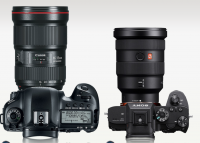I mean people weren't exactly shitting on Nikon for keeping the F Mount when Canon introduced the EF mount back in the days so it might be a similar scenario here. Plus the oh so new and innovative Z mount is pretty close to the EF mount. Fully electronic communication and just one mm more diameter for the Z mount. Seems like the EF mount was already p mirrorless-ready back in the days.I completely understand your point, but in ten years, when most (?) people will have moved to mirrorless (imo), how will people react when they see the limitations of that retro-compatibility? Will people now criticize Canon for that decision?
I'm guessing Canon won't reinvent a completely new mount in just 10 years right?
I'm nowhere near an expert on the subject so keep in mind I'm just speculating here. But I think it's a mistake to limit the future because of the current/past. If Canon keeps that flange distance on their new mount, then every mirrorless camera in the next 20-30 years will be bigger for no reason.
[EDIT] I know size is not the only advantage of mirrorless but for many people, it is one important aspect.
I think all of this comes down to some lens design changes for any RF (or EF-R?) lenses making them incompatible / unusable for normal EF cameras.
Upvote
0


